Santiago Travel Guide
The magnificent Andes Mountains provide an awesome backdrop for the sprawling Chilean metropolis of Santiago. The population of Chile's capital numbers more than six million but, with its relatively compact size, pretty leafy suburbs and well-oiled infrastructure, it is by no means an intimidating city.
Santiago is a curious mix of skyscrapers and 19th-century European architecture, with some Spanish-style bungalows thrown in for good measure. Threaded through this architectural tapestry are numerous green spaces, busy markets and quaint old squares. Street life is vibrant and the presence of many chic sidewalk cafes, outside of which traditionally dressed women hawk their wares hoping to catch the eye of the tourists, adds to the vibe. There are also some impressive museums, great accommodation options for all budgets, excellent restaurants and good shopping opportunities. The public transport is excellent, making getting around in the city centre a doddle.
Santiago exudes an aura of health and wealth in the inner city and fashionable suburbs, with a distinctly cosmopolitan and first-world atmosphere, but those who explore beyond the thriving centre will find that the glittering skyscrapers slowly give way to shabby shantytowns. The city is also one of the 10 most severely polluted in the world, thanks to its position in a bowl of mountains, which comes as a surprise in a country known for its pristine natural landscapes. Luckily, air pollution is only likely to be a problem in Santiago in the winter months, peaking between May and August, and usually dissipates in the sunny summers.
Santiago is an excellent base for exploring the Central Valley of Chile, with the lovely wine country on its doorstep and the artistic port city of Valparaiso a short drive away. National parks and even ski slopes are also within easy reach. Visitors may find, however, that the delights of the city itself make them loathe to leave.
Things to do in Santiago
There are many worthwhile things to see and do in Santiago for travellers. A fantastic way to start familiarising themselves with this vibrant and busy city is to pay a visit to the Plaza de Armas, Santiago's central square. Many of the destination's main attractions are in walking distance of this classic colonial meeting space. There are also brilliant walking tours with a group called Spicy Chile, who offer different walks each day to give tourists an introduction to the city. The guides are knowledgeable locals and the tours are free (although tips are expected).
There are a number of small but interesting museums in Santiago, the best of which is the Chilean Museum of Pre-Colombian Art, a must see for those interested in the ancient cultures of South America. Visitors travelling in Santiago with kids should also pop into the Museo Interactivo Mirador, a huge interactive museum with lots of educational activities and play areas. Another deservedly popular attraction in Santiago is Pablo Neruda's home: the late Nobel-winning poet's house is colourful, eccentric and romantic and worth a visit even for those unfamiliar with his poetry. It is called La Chascona, which means 'tousled hair', a name given in honour of his third wife.
San Cristobal Hill is a must for great views of the city and a refreshing dose of greenery and clean air. Santiago's parks and green spaces are a delight and it is never hard to find somewhere to relax in the shade. Visitors can try the Mercado Central seafood market, a bustling market that offers a massive variety of seafood fresh from the ocean.
Many travellers stop off in Santiago as a base for adventures out in the surrounding mountains; it has become a renowned area for ecotourism and travellers can take their pick of exciting outdoor activities, including skiing, horse riding, climbing and hiking. Those looking for a more mellow experience of the beautiful surroundings of Santiago should take a tour of the famous wine country just outside the city.
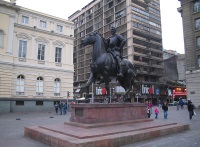
Plaza de Armas
The Plaza de Armas is both the heart of Santiago and the city's historical centre, a square hemmed in by impressive Spanish colonial public buildings, including the 18th-century Cathedral and elaborate main post office that was once the Spanish governor's residence. As with most colonial squares of this kind, and as the name suggests, the Plaza de Armas was designed to be the open space in which the armed forces of the city could gather to parade and to protect Santiago's most important buildings.
The square became the hub of administrative, commercial and social life when the city was founded in 1541, and today it remains the centre of life in the city. Never a dull place to be by day, with its constant activity and throngs of people entertained by buskers and local artists, the evenings are just as lively, when passers-by can become embroiled in chess games on temporary tables set up under the trees.
This square is the point from which all distances are measured in Chile, and the central point for the grid pattern of the streets. Visitors should be aware of their belongings here as it is a popular target spot among pickpockets. Nevertheless, the square is a useful starting point for sightseeing in Santiago, as many attractions are close by.
Chilean Museum of Pre-Columbian Art
The Chilean Museum of Pre-Colombian Art is a fascinating place to spend a few hours and is a great find for art and archaeology enthusiasts. Housed in the old Royal Customs House in Santiago, its collection is impressively large compared to many other museums in a similar vein, and spans around 4,500 years and 80 pre-Columbian civilisations of South America. Exhibits are beautifully curated and the collection provides an informative insight into the cultures of the Incas, Mayans, Aztecs and other proud civilisations of the continent, illustrating their artistic diversity and advancement. It is worth paying extra for a guided tour, though, as the labels are not translated into many languages and are not as comprehensive as some might like.
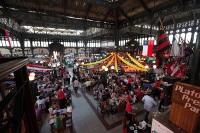
Mercado Central
Santiago's colourful Mercado Central is housed in an 1872 wrought-iron structure, and has a fruit and vegetable market as well as a buzzing fish market where an assortment of glistening fresh seafood is packed onto tables. Mussels, oysters and clams sit in buckets among an immense variety of crustaceans and tentacled creatures. The fishmongers demonstrate their skill at gutting and filleting amid a cacophony of frenzied buying. The best time to visit is at lunchtime, when a delicious sampling of the wares can be enjoyed in the happily chaotic atmosphere of the central hall.
There are many restaurants to choose from and often the smaller ones are the best (and a bit cheaper). Mercado Central can be rather expensive owing to its increasing popularity among tourists, so visitors should be on the lookout for bargains. It can be crowded and chaotic, but the seafood is excellent and always fresh, the architecture is interesting, and there is a festive feel to the place (partly thanks to the street musicians who frequent it). It is essentially a food market but there are usually some vendors selling souvenirs, jewellery and the like as well. It's advised that visitors stay aware and keep hold of their possessions, as pickpockets often target markets of this kind.
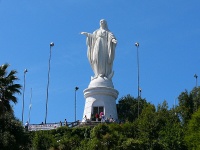
Cerro San Cristóbal
Cerro San Cristobal is a 2,752-foot (860m) hill that rises above central Santiago and, on a clear day, affords magnificent views of the surrounding city, all the way across to the Andes. The easiest way to the top is by funicular, but there is also a teleferico (cable car), bus or hiking path leading up from the bottom through the forested slopes. There are many walkways and, at the summit, the 70-foot (22m) high statue of the Virgin Mary to mark where the Pope held a mass in 1987. Visitors will find picnic sites on the lower slopes and the park also contains two outdoor swimming pools. The hill is situated within Santiago's biggest open space, the tranquil Parque Metropolitano, which makes for a peaceful escape from the bustle of the city. Visitors need a few hours to enjoy the park and, on a sunny day, the swimming pools are a delight.
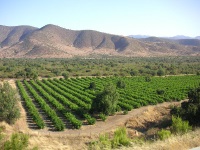
Wine Country
Chilean wine enjoys a good reputation among sommeliers all around the world, with its popularity continuing to soar. Central Chile's Mediterranean climate is ideal for vineyards, and some of the best wine comes from the Central Valley around Santiago. Needless to say, wine tastings are a popular activity in Santiago, and there are many wineries to choose from. Valle de Maipo, Valle de Casablanca and Valle de San Antonio are the closest to the city, and there are nearly 30 wineries in Valle de Maipo alone. Wine country in Chile stretches for many miles along the coast, from Valle de Elqui in the north to Valle de Malleco in the south.
Chilean wine country is an especially beautiful region in the summer, and a great way to explore the area is on bicycles, which can easily be hired in nearby towns. Some groups of wineries have banded together to offer established tours along 'wine routes', of which the circuit of the Colchagua Valley is the most popular. Many tour operators in Santiago offer wine tasting packages as well.
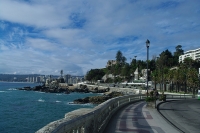
Vina del Mar
Vina del Mar is a short bus ride from Santiago, right next to Valparaiso; in fact, travellers could be forgiven for thinking the two coastal cities are one and the same. Vina del Mar has a vastly different character to bohemian Valparaiso, though. It is a safer, more manicured city celebrated for its fun resort culture, malls and beautiful beaches. Vina del Mar translates as 'Vineyard of the Sea', and the city's beautiful parks have earned it the romantic nickname of Ciudad Jardin, or 'Garden City'.
Pretty Vina del Mar is a popular summer resort and weekend retreat for the wealthy inhabitants of Santiago with a rollicking nightlife, good restaurant scene, and beaches and casinos that boom in the peak summer months between December and February. Though Vina del Mar's picturesque beaches are its biggest drawcards, they are not always safe for swimming. Visitors should be careful not to underestimate the power of the waves and currents and should obey directives from lifeguards.
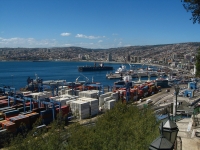
Valparaiso
Located just 75 miles (120km) from Santiago, Valparaiso is a major seaport and has a real bohemian spirit. It is an historic port city; in fact, in the 1800s it was the main shipping hub of the Southern Pacific, which brought wealth and floods of European immigrants, and created the debaucherous atmosphere that was often present in places where sailors congregated.
Valparaiso clings to the steep sides of 45 hills along the coast, a tricky geography that makes epic staircases and quaint old funiculars integral to getting around. The city is a UNESCO World Heritage site and home to a wealth of well-preserved historic architecture, but it is the highly modern street-art phenomenon that truly sets the place apart. The sheer amount of murals and graffiti, mixed up with grand old buildings, makes the whole city feel like a weird work of art. Adding another layer to this artsy atmosphere are the musicians who busk on seemingly every corner and artists selling their work at improvised stalls all over the picturesque hillside districts.
Unsurprisingly, Valparaiso is renowned for its vibrant nightlife and there is a surplus of cool places to eat and drink in the city. Apart from taking in the art, colourful architecture and numerous pubs, travellers should be sure to visit the quirky home of beloved poet Pablo Neruda, which offers glorious views over the city as well as insight into his life.
Shopping
Shopping in Santiago is a mixture of the old and new as bustling craft markets sit in the shadow of brand-new megamall complexes. The city is a major shopping destination, and visitors will find everything from tacky tourist items to high-end local brand names and international labels.
There are more than a few shopping malls in Santiago. The air-conditioned centres are popular on hot days, and most have food courts and movies to entertain children while their parents shop. Alto Las Condes and Parque Arauco are two of the biggest and best of Santiago's malls, with more than one hundred shops in each and a variety of entertainment options. Mall Vivo Panoramico is a good shopping centre to find mid-range items, and the 'Drugstore' on Avenida Providencia has a range of funky boutiques. Malls in Santiago are open seven days a week.
For tourists looking more for handicrafts than haute couture, Santiago has a few good craft markets that are great places to visit on a nice day. Patio Bellavista has a wealth of locally made goods, and is a good place to find souvenirs as well as good restaurants. Pueblito de los Dominicos, which is made up of small stores located inside an attractive old convent, also promises a wonderful array of local crafts in a picturesque setting. For cheap (but sometimes less authentic) souvenirs, Feria Artesanal Santa Lucia, on Cerro Santa Lucia, is another popular market with visitors.
Sought-after souvenirs include jewellery made with locally mined lapis lazuli, folk art, and alpaca scarves and jerseys. Chilean wine from the region around Santiago is also a good souvenir, particularly from well-regarded wineries such as Casa Julia and EQ.
Nightlife
A famously nocturnal city, the nightlife in Santiago often stays lively until the sun comes up. Locals may only go to dinner at 11pm, getting to nightclubs after 1am and staying until dawn. While some visitors may not have that sort of stamina, they shouldn't be surprised to find that clubs in Santiago often don't fill until midnight.
Much of Santiago's nightlife caters to people between 18 and 35, and live music is popular, spanning a wide range of musical styles from electronic to rock and jazz. Internationally renowned bands and musicians play at venues such as the Estado Nacional Julio Martinez Pradanos (the national stadium) and the Espacio Riesco.
Pio Nono has the highest density of bars in Santiago, and there are a number of high-end nightclubs surrounding the Plaza San Enrique. The Bellavista neighbourhood has a large number of nightclubs and bars, many of which stay open until as late as 5am, as well as a few relaxed venues with local music like tango, bolero and Latin jazz. Avenida Suecia, in the generally upmarket Providencia neighbourhood, was once considered the nightlife centre of Santiago, especially for foreigners, but the road developed a reputation for seediness and debauchery and most of the best venues have since closed down.
The legal drinking age in Chile is 18 and the locals are generally very welcoming and friendly on a night out. The party tends to spill out into the streets in a festive manner, especially in Bellavista, where the sidewalks are extensions of the various bars and restaurants.
There is a huge theatre community in Santiago, with offerings ranging from small independent productions to large-scale operas. Established theatres such as the Teatro Bellavista, Teatro Alcalá, and Estación Mapocho put on regular stage productions, but performances in English are few and far between. Tourists who don't speak Spanish will enjoy symphonies or ballets at the Teatro Municipal, Teatro Oriente and Teatro Universidad de Chile.
Getting Around
Public transport in Santiago is both efficient and practical for tourists. The Metro de Santiago is an easy and efficient way to get around in Santiago at a reasonable price and the system services most places of interest. MetroBuses serve the Metro stations to act as an extension to the rail system. Competing private companies run Santiago's many minibuses (micros), with their drivers working on a commission basis dependant on collecting as many fares as possible. Buses tend to race each other chaotically through the city's main streets and can be a dangerous option. Quicker and more comfortable are the colectivos, which have fixed routes and can take five passengers. They look like regular taxis, but display their route on the roof. Taxis can be hailed on any street corner, or radio taxis can be called to the door. Taxis are relatively inexpensive, but it is always best to decide on a rate before setting off as not all of the taxis are metered; taxi apps include Uber and Cabify. Although renting a car is possible, driving yourself around in Santiago is not recommended due to heavy congestion and limited parking. Santiago is also a good city for getting around on foot because it is arranged on a simple grid system that makes it easy to negotiate with a map.
Santiago Climate and Weather
The climate of Santiago is Mediterranean, with typically hot, dry summers and mild, moist winters. In summer, November to February, average temperatures hit highs of around 95F (35C). The summer months can be quite windy, with prevailing winds from the southwest. In winter, May to August, temperatures average around 57F (14C). Rain falls mainly during winter, which is a more humid season in Santiago. Snowfall is extremely rare in the city, although it is common in the Andes mountain range that looms above Santiago. Temperature inversions cause smog to be trapped in the valley for spells during the winter months, bringing heavy pollution. Unfortunately, the city is considered one of the most polluted in the world, largely because of its location in a natural bowl, and the smog is at its worst in winter. The best time to visit Santiago is in the summer months of December, January and February, although many people do visit in the winter to enjoy the skiing.
Chile travel info
Electricity
Electrical current is 220 volts, 50Hz. Round two-pin plugs and round three-pin plugs are used.
Language
The official language is Spanish.
Money
The local currency is the Chilean peso (CLP), which is divided into 100 centavos. Visa, MasterCard, Diners Club and to a lesser extent, American Express, are accepted in most large shops and hotels. ATMs are widely available.
Tipping
Tips of about 10 percent are expected in restaurants; it's usual to round up the fare for taxi drivers if they help with the luggage. Tipping small amounts is customary for most services.
Health
All eligible travellers should be up to date with their COVID-19 vaccines; vaccinations for hepatitis A, hepatitis B are recommended, and a typhoid vaccine may be recommended for long-term travellers who plan to visit rural areas and eat outside of hotels and restaurants. Water is generally safe in the cities, but should be treated in the rural areas; bottled water is widely available for drinking. Santiago is severely polluted and this could cause respiratory problems or eye irritations, particularly between May and August. Travellers visiting the Andes Mountains should be aware of altitude sickness, and ascend slowly to allow the body to adjust. Healthcare in urban areas is generally good, but hospitals and clinics are expensive. Comprehensive travel health insurance is recommended.
Safety
Chile is a politically stable country with few safety threats to travellers. Incidences of pick-pocketing and mugging are on the increase in big cities and travellers should take care of their belongings, especially around tourist areas and bus stations. Travellers should also avoid walking alone late at night, and should be particularly cautious in Valparaiso and the capital, Santiago, where theft is on the increase, and muggings are becoming more common in popular walking areas such as Cerro San Cristobal, Cerro Santa Lucia and Cerro Manquehue. There has been an increase in reports regarding people receiving spiked drinks at nightclubs and bars, particularly in Santiago. Travellers should avoid any involvement in political protests and demonstrations, which take place from time to time. Chile has a landmine problem, which is mainly restricted to border areas adjacent to Peru and Bolivia. These areas are seldom visited by most travellers, so landmines shouldn't be a problem. However, visitors are advised to stick to marked roads, obey all signs and seek the advice of local authorities if travelling to these areas.
Local customs
Although Chile is largely conservative in outlook, homosexuality is legal and is increasingly widely accepted socially. Punishment for the possession and consumption of drugs is illegal and can lead to prison sentences.
Doing business
Chilean business culture tends to be formal, and this includes dress, which should also be conservative. In business, Chileans should be addressed by their titles and surnames, unless otherwise stated. Businesses are often family run. Third party introductions are indispensable when arranging a meeting, and developing a personal relationship is key. Chileans often stand very close when conversing and it is impolite to pull away. Visitors are also expected to re-confirm appointments before arriving at a meeting. Foreigners should be on time for meetings, but it is not unusual for the host to be 15 to 30 minutes late. On introduction, a firm handshake and exchange of business cards is usual; cards should be printed in both English and Spanish, and it's important to pay attention to the card before putting it away carefully. Business hours are generally 9am to 5pm Monday to Friday, often with a siesta over lunch.
Duty free
Travellers entering Chile do not need to pay customs duty on 400 cigarettes, 50 cigars (large or small) and 500g tobacco; 2.5 litres of alcohol; and perfume for personal use. Meat products, flowers, fruit and vegetables may only be imported if permission is given by the Department of Agriculture.
Communications
The international access code for Chile is +56. The outgoing code is 00 followed by the relevant country code (e.g. 0044 for the United Kingdom). Hotels, cafes and restaurants offering free WiFi are widely available. As international roaming costs can be high, purchasing a local prepaid SIM card can be a cheaper option.
Passport & Visa
A return or onward ticket is required, and it's recommend that passports be valid for six months after the intended period of travel. Extension of stay is possible for an additional 90 days for visa exempt visitors.
Entry requirements
No visa is required by US nationals for visits of up to 90 days, though a passport valid on arrival is required for travel to Chile. Travellers who visit Easter Island are allowed to stay for a maximum of 30 days.
UK nationals do not require a visa for visits of up to 90 days, though a passport valid on arrival is required. Travellers who visit Easter Island are allowed to stay for a maximum of 30 days.
No visa is required by Canadians for visits of up to 90 days; a passport valid on arrival is required for travel to Chile. Travellers who visit Easter Island are allowed to stay for a maximum of 30 days.
Australian nationals require a visa and passport valid on arrival. Travellers who visit Easter Island are allowed to stay for a maximum of 30 days.
South African nationals must hold a passport valid on arrival, though a visa is not required for stays of up to 90 days. Travellers who visit Easter Island are allowed to stay for a maximum of 30 days.
Irish nationals must hold a passport valid on arrival, but a visa is not required for a stay of up to 90 days. Travellers who visit Easter Island are allowed to stay for a maximum of 30 days.
New Zealand nationals must hold a passport valid on arrival, though a visa is not required for a stay of up to 90 days. Travellers who visit Easter Island are allowed to stay for a maximum of 30 days.
Useful contacts
Chile National Tourism Website: www.chile.travel
133 (Police); 131 (Medical)Embassies / consulates in other countries
Embassy of Chile, Washington DC, United States: +1 202 530 4104.
Embassy of Chile, London, United Kingdom: +44 (0)20 7222 2361.
Embassy of Chile, Ottawa, Canada: +1 613 235 4402.
Embassy of Chile, Canberra, Australia: +61 (0)2 6286 2430.
Embassy of Chile, Pretoria, South Africa: +27 (0)12 460 8090.
Embassy of Chile, Dublin, Ireland: +353 (0)1 667 5094.
Embassy of Chile, Wellington, New Zealand: +64 (0)4 471 6270.
Embassies / consulates in Chile
United States Embassy, Santiago: +56 (0)2 330 3000
British Embassy, Santiago: +56 (0)2 370 4100.
Canadian Embassy, Santiago: +56 (0)2 652 3800.
Australian Embassy, Santiago: +56 (0)2 550 3500.
South African Embassy, Santiago: +56 (0)2 8200 300.
Embassy of Ireland, Buenos Aires (also responsible for Chile): +54 11 5787 0801.
New Zealand Embassy, Santiago: +56 (0)2 616 3000.



